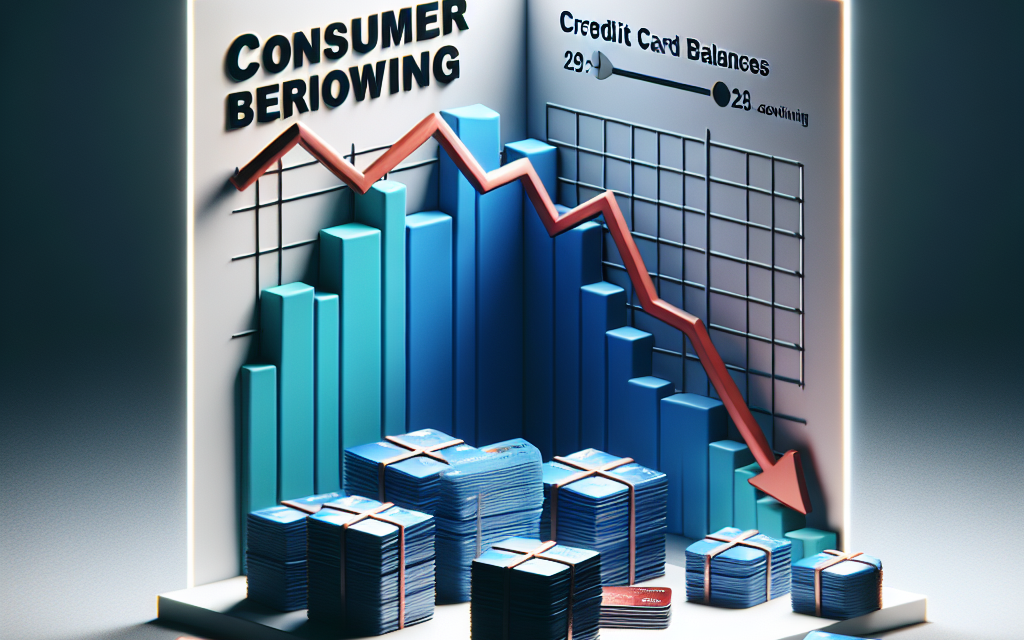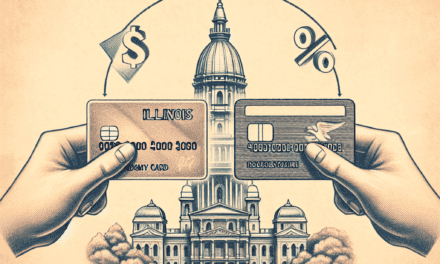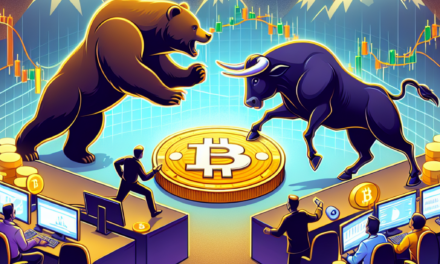“US Consumer Borrowing Drops as Credit Card Balances Take a Tumble.”
Introduction
In recent months, U.S. consumer borrowing has experienced a notable decline, primarily driven by a decrease in credit card balances. This trend reflects shifting consumer behavior as individuals become more cautious about their spending and debt accumulation. As economic uncertainties persist, many consumers are prioritizing financial stability, leading to reduced reliance on credit. The decline in borrowing not only highlights changing attitudes towards debt but also signals potential implications for the broader economy, including consumer spending patterns and credit market dynamics.
Impact of Declining Credit Card Balances on Consumer Borrowing
In recent months, a notable trend has emerged in the realm of consumer finance: a decline in credit card balances, which has subsequently impacted overall consumer borrowing. This shift is significant, as it reflects changing behaviors among consumers and the broader economic landscape. As individuals become more cautious about their spending habits, the implications of reduced credit card debt extend beyond personal finance, influencing economic indicators and lending practices.
To begin with, the decrease in credit card balances suggests that consumers are prioritizing financial stability over impulsive spending. Many individuals are opting to pay down existing debt rather than accumulating more, which can be attributed to a variety of factors, including rising interest rates and inflationary pressures. As the cost of living increases, consumers are becoming more aware of their financial situations, leading to a more conservative approach to borrowing. This shift is particularly evident in the way consumers are managing their credit cards, often choosing to limit their usage or pay off balances in full each month to avoid high-interest charges.
Moreover, the decline in credit card balances has a direct impact on overall consumer borrowing. When consumers reduce their reliance on credit cards, it results in a decrease in revolving credit, which is a significant component of total consumer debt. This reduction can lead to a more favorable credit environment, as lower credit card balances can improve credit scores. Consequently, consumers may find themselves in a better position to secure loans for major purchases, such as homes or vehicles, as lenders view them as less risky borrowers. This dynamic can stimulate other sectors of the economy, as increased access to credit can encourage spending in areas that drive economic growth.
In addition to influencing individual borrowing capacity, the decline in credit card balances also affects lending institutions. Banks and credit unions may respond to the reduced demand for credit by tightening their lending standards or adjusting interest rates. As consumers exhibit more caution in their borrowing habits, lenders may perceive a need to recalibrate their risk assessments. This could lead to a more conservative lending environment, where only those with strong credit profiles are approved for loans. While this may protect lenders from potential defaults, it could also hinder economic growth by limiting access to credit for those who may benefit from it.
Furthermore, the broader economic implications of declining credit card balances cannot be overlooked. Consumer spending is a critical driver of economic activity, and a reduction in credit card debt may signal a shift in consumer confidence. When individuals feel secure in their financial situations, they are more likely to engage in discretionary spending, which can stimulate demand for goods and services. Conversely, if consumers remain hesitant to borrow, it could lead to a slowdown in economic growth, as businesses may experience reduced sales and revenue.
In conclusion, the decline in credit card balances is a multifaceted issue that has significant implications for consumer borrowing and the broader economy. As consumers adopt more prudent financial practices, the effects ripple through lending institutions and economic indicators. While this trend may reflect a more cautious approach to personal finance, it also raises questions about future consumer behavior and its potential impact on economic growth. As the landscape continues to evolve, stakeholders must remain vigilant in monitoring these changes to understand their long-term effects on the economy.
Trends in US Consumer Debt: A Shift in Borrowing Patterns
In recent months, a notable trend has emerged in the landscape of consumer debt in the United States, characterized by a decline in overall borrowing, particularly in the realm of credit card balances. This shift in borrowing patterns reflects a broader change in consumer behavior, influenced by various economic factors and a growing awareness of financial management. As consumers navigate the complexities of their financial situations, the implications of this decline in borrowing extend beyond individual households, impacting the economy at large.
To begin with, the decrease in credit card balances suggests that consumers are becoming more cautious in their spending habits. This cautiousness can be attributed to several factors, including rising interest rates, inflationary pressures, and a heightened focus on personal financial health. As interest rates have increased, the cost of borrowing has risen, prompting consumers to reconsider their reliance on credit cards for everyday purchases. Consequently, many individuals are opting to pay down existing debt rather than accumulate additional charges, leading to a reduction in overall credit card balances.
Moreover, this trend is indicative of a broader shift towards more responsible financial practices among consumers. In recent years, there has been a growing emphasis on financial literacy, with many individuals seeking to better understand their financial situations and make informed decisions. This newfound awareness has encouraged consumers to prioritize saving and budgeting over impulsive spending, resulting in a more disciplined approach to borrowing. As consumers become more adept at managing their finances, the decline in credit card balances may signal a long-term change in borrowing behavior, one that favors sustainability over short-term gratification.
In addition to these behavioral changes, external economic factors have played a significant role in shaping consumer borrowing patterns. The ongoing economic recovery, coupled with fluctuating inflation rates, has created an environment where consumers are more mindful of their financial commitments. As prices for essential goods and services continue to rise, many individuals are finding it increasingly challenging to maintain their previous spending levels. This reality has led to a natural recalibration of consumer priorities, with many choosing to focus on essential expenditures and debt reduction rather than discretionary spending.
Furthermore, the decline in consumer borrowing may also reflect a broader trend in the credit market. Lenders have become more stringent in their lending practices, resulting in tighter credit conditions for consumers. This shift has made it more difficult for individuals to access credit, particularly for those with lower credit scores or unstable financial situations. As a result, many consumers may be opting to forgo borrowing altogether, leading to a decrease in overall credit card usage and balances.
As we look ahead, it is essential to consider the potential long-term implications of these trends in consumer debt. A sustained decline in borrowing could lead to a healthier financial landscape for many households, fostering a culture of savings and responsible spending. However, it is also crucial to recognize that a significant reduction in consumer borrowing may have repercussions for economic growth, as consumer spending is a vital driver of the economy. Balancing the need for responsible financial practices with the necessity of maintaining economic momentum will be a critical challenge for policymakers and consumers alike.
In conclusion, the decline in US consumer borrowing, particularly in credit card balances, reflects a significant shift in borrowing patterns. This trend is driven by a combination of increased financial awareness, external economic pressures, and changing lending practices. As consumers adapt to these new realities, the implications for both individual households and the broader economy will continue to unfold, shaping the future of consumer debt in the United States.
The Role of Interest Rates in Consumer Borrowing Declines
In recent months, the landscape of consumer borrowing in the United States has undergone notable changes, particularly as credit card balances have experienced a decline. This shift can be attributed to several factors, with interest rates playing a pivotal role in shaping consumer behavior and financial decision-making. As the Federal Reserve has adjusted interest rates in response to economic conditions, the implications for consumer borrowing have become increasingly evident.
To begin with, it is essential to understand the relationship between interest rates and consumer borrowing. When interest rates rise, the cost of borrowing increases, which can lead to a decrease in consumer demand for credit. Higher rates make loans more expensive, prompting consumers to reconsider their spending habits and borrowing needs. Consequently, many individuals may opt to pay down existing debt rather than incur additional charges, resulting in a decline in overall credit card balances. This trend has been particularly pronounced in an environment where the Federal Reserve has implemented a series of interest rate hikes aimed at curbing inflation.
Moreover, the impact of rising interest rates extends beyond just credit cards. Consumers are also affected in their decisions regarding personal loans, auto financing, and mortgages. As borrowing costs escalate, individuals may find themselves more cautious about taking on new debt. This cautious approach can lead to a broader decline in consumer borrowing, as people prioritize financial stability over immediate consumption. In this context, the decline in credit card balances can be seen as part of a larger trend of consumers reassessing their financial priorities in light of changing economic conditions.
In addition to the direct effects of interest rates, there is also a psychological component at play. When consumers perceive that borrowing costs are on the rise, they may become more risk-averse, leading to a shift in their financial behavior. This shift can manifest in various ways, such as increased savings rates and a greater emphasis on budgeting. As consumers become more mindful of their financial situations, they may choose to limit their reliance on credit cards, further contributing to the observed decline in balances.
Furthermore, the economic environment characterized by rising interest rates often coincides with heightened uncertainty. In such times, consumers may be more inclined to adopt a conservative approach to their finances, focusing on debt reduction and savings accumulation. This behavior is particularly relevant in the context of credit cards, which are often associated with higher interest rates and the potential for accumulating debt. As consumers become more aware of the long-term implications of high-interest debt, they may prioritize paying down their credit card balances, leading to a decrease in overall borrowing.
In conclusion, the decline in consumer borrowing, particularly in the realm of credit card balances, can be largely attributed to the role of interest rates. As borrowing costs rise, consumers are prompted to reevaluate their financial strategies, often resulting in a more cautious approach to credit. This trend reflects a broader shift in consumer behavior, driven by both economic conditions and psychological factors. Ultimately, as interest rates continue to influence the financial landscape, the implications for consumer borrowing will remain a critical area of observation for economists and policymakers alike. Understanding these dynamics is essential for anticipating future trends in consumer credit and overall economic health.
Analyzing the Relationship Between Credit Card Usage and Consumer Spending
In recent months, a notable decline in consumer borrowing has been observed, particularly in the realm of credit card usage. This trend raises important questions about the intricate relationship between credit card balances and overall consumer spending. As credit card balances decrease, it is essential to analyze how this shift impacts consumer behavior and the broader economy.
To begin with, credit cards have long been a staple of consumer finance, providing individuals with a convenient means to make purchases and manage cash flow. However, the reliance on credit cards can also lead to increased debt levels, which may ultimately constrain consumer spending. When consumers carry high credit card balances, they often allocate a significant portion of their income toward servicing that debt, leaving less available for discretionary spending. Consequently, a reduction in credit card balances can signal a shift in consumer behavior, potentially leading to increased spending power.
Moreover, the decline in credit card usage may reflect broader economic conditions. For instance, when consumers feel uncertain about their financial future, they may be more inclined to reduce their reliance on credit. This cautious approach can result in lower credit card balances, as individuals prioritize saving over spending. In this context, the decrease in borrowing may not only indicate a shift in consumer preferences but also a response to economic signals, such as rising interest rates or inflationary pressures. As consumers become more mindful of their financial health, they may choose to limit their credit card usage, thereby impacting overall spending patterns.
Additionally, the relationship between credit card balances and consumer spending is influenced by various external factors, including employment rates and wage growth. When job security is high and wages are increasing, consumers may feel more confident in their financial situation, leading to higher credit card usage and, consequently, increased spending. Conversely, in times of economic uncertainty, consumers may opt to pay down existing debt rather than accumulate more, resulting in a decline in credit card balances. This dynamic illustrates how consumer sentiment and economic conditions are intertwined, ultimately shaping spending behaviors.
Furthermore, the rise of alternative payment methods, such as digital wallets and buy-now-pay-later services, has also contributed to the changing landscape of consumer borrowing. As these options become more prevalent, consumers may find themselves relying less on traditional credit cards. This shift not only affects credit card balances but also alters the way consumers approach spending. With more flexible payment options available, individuals may feel empowered to make purchases without the immediate burden of credit card debt, thereby influencing their overall spending habits.
In conclusion, the decline in consumer borrowing, particularly in the context of falling credit card balances, highlights a complex interplay between credit card usage and consumer spending. As individuals become more cautious about their financial health, they may prioritize debt reduction over spending, which can have significant implications for the economy. Additionally, external factors such as economic conditions and the emergence of alternative payment methods further shape this relationship. Understanding these dynamics is crucial for policymakers and financial institutions as they navigate the evolving landscape of consumer finance and its impact on economic growth.
Economic Implications of Falling Credit Card Balances
In recent months, the landscape of consumer borrowing in the United States has undergone a notable transformation, particularly marked by a decline in credit card balances. This shift carries significant economic implications that merit careful examination. As consumers reduce their reliance on credit cards, it reflects broader trends in financial behavior and economic sentiment, which can influence various sectors of the economy.
To begin with, the decrease in credit card balances suggests a growing sense of financial prudence among consumers. Many individuals are becoming increasingly aware of the potential pitfalls associated with high-interest debt, leading them to prioritize savings and responsible spending. This trend is particularly relevant in the context of rising interest rates, which have made borrowing more expensive. As consumers opt to pay down existing debt rather than accumulate more, it indicates a shift towards a more cautious approach to personal finance. This behavior can be seen as a response to economic uncertainties, including inflationary pressures and fluctuating job markets, prompting individuals to reassess their financial strategies.
Moreover, the decline in credit card balances can have ripple effects throughout the economy. When consumers reduce their borrowing, it can lead to a decrease in overall consumer spending, which is a critical driver of economic growth. Retailers and service providers may experience a slowdown in sales as consumers become more selective about their purchases. This, in turn, can impact businesses’ revenue streams and potentially lead to a slowdown in hiring or investment. Consequently, a prolonged period of reduced consumer spending could hinder economic recovery, particularly in sectors that rely heavily on discretionary spending.
In addition to affecting consumer behavior, falling credit card balances may also influence lending practices among financial institutions. Banks and credit card companies may respond to decreased borrowing by tightening their lending standards, making it more challenging for consumers to access credit. This could create a feedback loop where reduced access to credit further dampens consumer spending, exacerbating the economic slowdown. Conversely, if financial institutions perceive the decline in credit card balances as a sign of improved consumer financial health, they may adjust their lending strategies to encourage responsible borrowing, potentially stimulating economic activity.
Furthermore, the implications of falling credit card balances extend to the broader financial markets. Investors closely monitor consumer debt levels as an indicator of economic stability. A significant decline in credit card balances may signal a shift in consumer confidence, which can influence market sentiment. If investors interpret this trend as a sign of economic weakness, it could lead to increased volatility in financial markets, affecting stock prices and investment strategies.
In conclusion, the decline in credit card balances among U.S. consumers is a multifaceted phenomenon with far-reaching economic implications. As individuals adopt more cautious financial behaviors, the effects ripple through consumer spending, lending practices, and financial markets. While this trend may reflect a positive shift towards financial responsibility, it also poses challenges for economic growth and stability. Policymakers and economists must closely monitor these developments to understand their potential impact on the broader economy and to devise strategies that support sustainable growth in the face of changing consumer behaviors. Ultimately, the interplay between consumer borrowing and economic health remains a critical area of focus as the nation navigates its financial future.
Strategies for Consumers to Manage Debt in a Declining Borrowing Environment
As the landscape of consumer borrowing shifts, particularly with recent declines in credit card balances, it becomes increasingly important for individuals to adopt effective strategies for managing their debt. In a declining borrowing environment, where credit availability may tighten and interest rates fluctuate, consumers must be proactive in their financial planning to maintain stability and avoid potential pitfalls.
One of the first steps consumers can take is to create a comprehensive budget that accurately reflects their income and expenses. By tracking spending habits, individuals can identify areas where they may be overspending and make necessary adjustments. This practice not only helps in managing current debt but also fosters a greater awareness of financial health. Additionally, setting aside a portion of income for savings can provide a buffer against unexpected expenses, reducing the need to rely on credit in times of financial strain.
Moreover, prioritizing high-interest debt repayment is crucial in a declining borrowing environment. Consumers should focus on paying off credit card balances first, as these typically carry the highest interest rates. By employing strategies such as the avalanche or snowball method, individuals can systematically reduce their debt load. The avalanche method involves paying off debts with the highest interest rates first, while the snowball method focuses on paying off the smallest debts first to build momentum. Both approaches can lead to significant savings on interest payments over time and contribute to a more manageable debt situation.
In addition to these strategies, consumers should consider consolidating their debts if they find themselves overwhelmed by multiple credit obligations. Debt consolidation can simplify payments by combining several debts into a single loan with a potentially lower interest rate. This not only streamlines the repayment process but can also reduce monthly payments, making it easier for consumers to stay on track. However, it is essential to approach consolidation with caution, as it may involve fees or extended repayment terms that could ultimately lead to higher costs.
Furthermore, consumers should remain vigilant about their credit scores, as these scores play a critical role in determining borrowing capacity and interest rates. Regularly reviewing credit reports for inaccuracies and addressing any discrepancies can help maintain a healthy credit profile. Additionally, making timely payments and keeping credit utilization low are fundamental practices that contribute positively to credit scores. In a declining borrowing environment, a strong credit score can provide access to better loan terms and lower interest rates when borrowing becomes necessary.
Lastly, seeking financial education and professional advice can empower consumers to make informed decisions regarding their debt management. Numerous resources are available, including workshops, online courses, and financial counseling services. By enhancing their financial literacy, individuals can better navigate the complexities of debt and develop personalized strategies that align with their unique circumstances.
In conclusion, as consumer borrowing declines and credit card balances fall, it is imperative for individuals to adopt effective debt management strategies. By creating a budget, prioritizing high-interest debt repayment, considering consolidation, monitoring credit scores, and seeking financial education, consumers can navigate this changing landscape with confidence. Ultimately, these proactive measures will not only help in managing current debt but also lay the groundwork for a more secure financial future.
Future Outlook: What Declining Borrowing Means for the US Economy
The recent decline in consumer borrowing in the United States, particularly marked by a decrease in credit card balances, presents a multifaceted scenario for the future of the U.S. economy. As consumers pull back on their borrowing habits, it is essential to consider the implications of this trend on economic growth, consumer spending, and overall financial stability. The reduction in credit card debt suggests a shift in consumer behavior, potentially driven by rising interest rates and a growing awareness of personal financial management. This shift may indicate a more cautious approach to spending, which could have both positive and negative ramifications for the economy.
On one hand, a decline in consumer borrowing can lead to a healthier financial landscape for households. With lower credit card balances, consumers may experience reduced financial stress, allowing them to allocate more of their income toward savings and investments. This newfound financial prudence can foster a more resilient consumer base, capable of weathering economic downturns. Furthermore, as consumers prioritize paying down debt, the overall level of household debt may decrease, contributing to a more stable economic environment. This stability can enhance consumer confidence, which is crucial for sustained economic growth.
Conversely, a significant reduction in borrowing may signal a slowdown in consumer spending, which is a critical driver of the U.S. economy. When consumers are less willing to take on debt, their purchasing power diminishes, potentially leading to decreased demand for goods and services. This decline in demand can have a cascading effect on businesses, resulting in lower revenues, reduced production, and potentially, job losses. As companies adjust to a less favorable consumer spending environment, they may be compelled to cut back on investments and expansion plans, further stifling economic growth.
Moreover, the interplay between consumer borrowing and interest rates cannot be overlooked. The Federal Reserve’s monetary policy decisions, particularly regarding interest rates, play a pivotal role in shaping borrowing behaviors. As interest rates rise, the cost of borrowing increases, which may deter consumers from taking on new debt. This dynamic can lead to a contraction in credit availability, as lenders become more cautious in their lending practices. Consequently, a tighter credit environment may exacerbate the decline in consumer borrowing, creating a feedback loop that could hinder economic recovery.
In addition to these immediate effects, the long-term implications of declining consumer borrowing warrant consideration. If consumers continue to prioritize debt reduction over spending, the economy may experience a prolonged period of subdued growth. This scenario could challenge policymakers, who must balance the need for economic stimulation with the imperative of maintaining financial stability. As such, the Federal Reserve and other economic authorities may need to adopt strategies that encourage responsible borrowing while also fostering an environment conducive to consumer spending.
In conclusion, the decline in consumer borrowing, particularly through reduced credit card balances, presents a complex landscape for the U.S. economy. While it may lead to improved financial health for consumers, it also raises concerns about potential slowdowns in spending and economic growth. As the nation navigates this evolving financial terrain, the interplay between consumer behavior, interest rates, and economic policy will be critical in shaping the future trajectory of the economy. Ultimately, understanding these dynamics will be essential for stakeholders aiming to foster a balanced and sustainable economic environment.
Q&A
1. **Question:** What recent trend has been observed in US consumer borrowing?
**Answer:** US consumer borrowing has declined.
2. **Question:** What specific type of debt has contributed to this decline?
**Answer:** Credit card balances have fallen.
3. **Question:** What might be a reason for the decrease in credit card balances?
**Answer:** Consumers may be paying down debt or reducing spending.
4. **Question:** How does a decline in consumer borrowing affect the economy?
**Answer:** It can indicate reduced consumer confidence and spending, potentially slowing economic growth.
5. **Question:** What other forms of consumer debt are included in borrowing statistics?
**Answer:** Other forms include auto loans, student loans, and personal loans.
6. **Question:** How do interest rates influence consumer borrowing behavior?
**Answer:** Higher interest rates can discourage borrowing and lead to reduced credit card usage.
7. **Question:** What implications does falling credit card debt have for financial institutions?
**Answer:** It may lead to lower revenue from interest and fees for banks and credit card companies.
Conclusion
US consumer borrowing has declined, primarily driven by a decrease in credit card balances. This trend suggests that consumers are becoming more cautious with their spending and managing debt more effectively. The reduction in credit card debt may indicate a shift towards more responsible financial behavior, potentially influenced by rising interest rates and economic uncertainty. Overall, the decline in consumer borrowing reflects a broader trend of financial prudence among American households.





